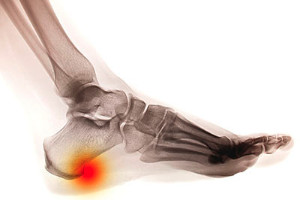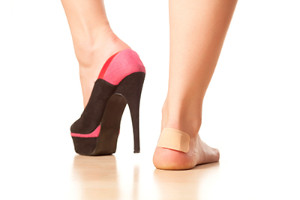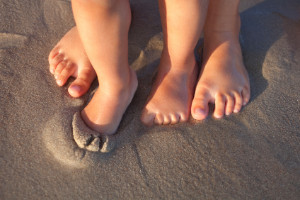August 2022
Common Causes of Foot Pain

Almost everyone experiences foot pain at some point. Barring traumatic injury, the most common causes of foot pain are bunions, plantar fasciitis, ingrown toenails, and athlete’s foot. A bunion is a bony protrusion at the base of the big toe, often caused by genetics and made worse from arthritis. Improper footwear can aggravate a bunion, which then may cause hammertoes, calluses, and metatarsal pain. Plantar fasciitis is an inflammation of the band of tissue that runs along the sole of the foot. While painful, it can be alleviated to a degree by wearing shoes with more cushioning and by doing certain exercises. Ingrown toenails can be quite painful, but they may be prevented by keeping toenails properly cut and wearing shoes with more room in the toe box. Athlete’s foot is a fungal infection that enters the foot through a tiny crack or sore. It causes itching, scaling and painful splitting of the skin between the toes. Highly contagious, athlete’s foot is often spread in moist, warm areas, including shower rooms and swimming pools. If you have any of these conditions, it is a good idea to check in with a podiatrist for a full examination, diagnosis, and options for treatment.
Foot Pain
Foot pain can be extremely painful and debilitating. If you have a foot pain, consult with Dr. Mark Spier from Maryland. Our doctor will assess your condition and provide you with quality foot and ankle treatment.
Causes
Foot pain is a very broad condition that could be caused by one or more ailments. The most common include:
- Bunions
- Hammertoes
- Plantar Fasciitis
- Bone Spurs
- Corns
- Tarsal Tunnel Syndrome
- Ingrown Toenails
- Arthritis (such as Gout, Rheumatoid, and Osteoarthritis)
- Flat Feet
- Injury (from stress fractures, broken toe, foot, ankle, Achilles tendon ruptures, and sprains)
- And more
Diagnosis
To figure out the cause of foot pain, podiatrists utilize several different methods. This can range from simple visual inspections and sensation tests to X-rays and MRI scans. Prior medical history, family medical history, and any recent physical traumatic events will all be taken into consideration for a proper diagnosis.
Treatment
Treatment depends upon the cause of the foot pain. Whether it is resting, staying off the foot, or having surgery; podiatrists have a number of treatment options available for foot pain.
If you have any questions, please feel free to contact one of our offices located in Columbia and Reisterstown, MD . We offer the newest diagnostic and treatment technologies for all your foot care needs.
Reasons a Heel Spur Can Develop

A calcium deposit that develops between the heel bone and the arch may be referred to as a heel spur. It is defined as a bony growth and it can cause little pain or the opposite, it may cause severe pain. They can gradually develop as a result of repetitive stress from walking, running, or participating in jumping activities. Additionally, wearing shoes that do not fit correctly may be a reason for a heel spur to develop as well as existing medical issues. Some people have had their heels bruised from an injury, they may have excess body weight, or they may have an abnormal gait or walking style. Heel spurs can have similar characteristics as other foot conditions, including plantar fasciitis and other forms of heel pain. Having an X-ray taken is the way to receive a proper diagnosis. Successful treatment often begins with resting the affected foot as often as possible and performing specific stretching techniques. If you have been afflicted with a heel spur, please confer with a podiatrist who can guide you toward the correct treatment which may include surgery for permanent removal.
Heel spurs can be incredibly painful and sometimes may make you unable to participate in physical activities. To get medical care for your heel spurs, contact Dr. Mark Spier from Maryland. Our doctor will do everything possible to treat your condition.
Heels Spurs
Heel spurs are formed by calcium deposits on the back of the foot where the heel is. This can also be caused by small fragments of bone breaking off one section of the foot, attaching onto the back of the foot. Heel spurs can also be bone growth on the back of the foot and may grow in the direction of the arch of the foot.
Older individuals usually suffer from heel spurs and pain sometimes intensifies with age. One of the main condition's spurs are related to is plantar fasciitis.
Pain
The pain associated with spurs is often because of weight placed on the feet. When someone is walking, their entire weight is concentrated on the feet. Bone spurs then have the tendency to affect other bones and tissues around the foot. As the pain continues, the feet will become tender and sensitive over time.
Treatments
There are many ways to treat heel spurs. If one is suffering from heel spurs in conjunction with pain, there are several methods for healing. Medication, surgery, and herbal care are some options.
If you have any questions feel free to contact one of our offices located in Columbia and Reisterstown, MD . We offer the latest in diagnostic and treatment technology to meet your needs.
How Does The Fungus That Causes Athlete’s Foot Enter the Body?

The foot condition known as athlete’s foot is a fungal infection of the skin. This type of fungus lives in damp areas such as public swimming pools, shower room floors, and locker rooms. The fungus enters the body through tiny cracks in the skin on the feet and can cause the feet to turn red and itch. In severe cases, small blisters may develop between the toes and generally require prompt medical attention. There are various reasons why athlete’s foot may develop consisting of family history, a weakened immune system, or existing medical conditions like eczema. This ailment is contagious, and it can be beneficial to wear appropriate shoes while in damp areas. Additional preventive methods can include alternating the shoes worn, refraining from sharing socks, shoes, or towels, and avoiding walking barefoot. Athlete’s foot can be uncomfortable and mild cases can heal in several weeks. If you notice your feet are not healing, it is strongly advised that you are under the care of a podiatrist who can effectively diagnose and treat athlete’s foot.
Athlete’s Foot
Athlete’s foot is often an uncomfortable condition to experience. Thankfully, podiatrists specialize in treating athlete’s foot and offer the best treatment options. If you have any questions about athlete’s foot, consult with Dr. Mark Spier from Maryland. Our doctor will assess your condition and provide you with quality treatment.
What Is Athlete’s Foot?
Tinea pedis, more commonly known as athlete’s foot, is a non-serious and common fungal infection of the foot. Athlete’s foot is contagious and can be contracted by touching someone who has it or infected surfaces. The most common places contaminated by it are public showers, locker rooms, and swimming pools. Once contracted, it grows on feet that are left inside moist, dark, and warm shoes and socks.
Prevention
The most effective ways to prevent athlete’s foot include:
- Thoroughly washing and drying feet
- Avoid going barefoot in locker rooms and public showers
- Using shower shoes in public showers
- Wearing socks that allow the feet to breathe
- Changing socks and shoes frequently if you sweat a lot
Symptoms
Athlete’s foot initially occurs as a rash between the toes. However, if left undiagnosed, it can spread to the sides and bottom of the feet, toenails, and if touched by hand, the hands themselves. Symptoms include:
- Redness
- Burning
- Itching
- Scaly and peeling skin
Diagnosis and Treatment
Diagnosis is quick and easy. Skin samples will be taken and either viewed under a microscope or sent to a lab for testing. Sometimes, a podiatrist can diagnose it based on simply looking at it. Once confirmed, treatment options include oral and topical antifungal medications.
If you have any questions, please feel free to contact one of our offices located in Columbia and Reisterstown, MD . We offer the newest diagnostic and treatment technologies for all your foot care needs.
Gait Changes Caused By High Heels

Many women wear high heels as a fashion statement and to increase their height. While these are certainly two important benefits of wearing high heels, there are also many risks. One potential risk of wearing high-heeled shoes is that it might detrimentally alter one’s gait, or walking pattern. For example, women who wear high heels sometimes exhibit shorter gait patterns and unconsciously point their toes. As a result, the gaits of these women exert more pressure on the calf muscles and can ultimately facilitate strain on the feet. Some women who wear high heels might even demonstrate these gait changes when they are not wearing high heels, such as when they are walking barefoot or in a pair of flats. Of course, sometimes wearing high heels can be an unavoidable choice. However, there are several things one might do to mitigate the extent to which high heels can change the gait. Namely, someone might limit the time that high heels are worn throughout the day and set a limit on the number of days in the week in which these shoes are worn. Contact a podiatrist for more information about how high heels can alter your gait.
High heels have a history of causing foot and ankle problems. If you have any concerns about your feet or ankles, contact Dr. Mark Spier from Maryland. Our doctor can provide the care you need to keep you pain-free and on your feet.
Effects of High Heels on the Feet
High heels are popular shoes among women because of their many styles and societal appeal. Despite this, high heels can still cause many health problems if worn too frequently.
Which Parts of My Body Will Be Affected by High Heels?
- Ankle Joints
- Achilles Tendon – May shorten and stiffen with prolonged wear
- Balls of the Feet
- Knees – Heels cause the knees to bend constantly, creating stress on them
- Back – They decrease the spine’s ability to absorb shock, which may lead to back pain. The vertebrae of the lower back may compress.
What Kinds of Foot Problems Can Develop from Wearing High Heels?
- Corns
- Calluses
- Hammertoe
- Bunions
- Morton’s Neuroma
- Plantar Fasciitis
How Can I Still Wear High Heels and Maintain Foot Health?
If you want to wear high heeled shoes, make sure that you are not wearing them every day, as this will help prevent long term physical problems. Try wearing thicker heels as opposed to stilettos to distribute weight more evenly across the feet. Always make sure you are wearing the proper shoes for the right occasion, such as sneakers for exercising. If you walk to work, try carrying your heels with you and changing into them once you arrive at work. Adding inserts to your heels can help cushion your feet and absorb shock. Full foot inserts or metatarsal pads are available.
If you have any questions please feel free to contact one of our offices located in Columbia and Reisterstown, MD . We offer the newest diagnostic and treatment technologies for all your foot and ankle needs.
Do Your Child's Feet Hurt?
Out-Toeing or Duck-Footedness in Children

As toddlers are learning to walk, their gait may be characterized as duck-footed, or out-toeing. This happens when they walk with their toes pointing outward rather than forward. In many children, this way of walking is temporary. A child will often outgrow this by age six to eight years of age. However, sometimes it can persist into adolescence, or even adulthood, and can lead to more serious complications. Out-toeing is a type of torsional deformity and usually occurs when one of the leg’s two longest bones (the tibia, located between the knee and ankle, and the femur, located between the hip and knee) turn towards the outside of the leg, causing the foot to jut out. This condition can occur in one or both legs. Most often, the child does not experience pain or discomfort with this condition, and it does not affect their mobility. Parents might see that their kid’s shoes wear out or have more obvious scuff marks on the outer edges of the shoes if the child is duck-footed. Causes of out-toeing include genetics, fetal position of the legs in the uterus prior to birth, the resting position of the legs during infancy, and being flat-footed. Rarer reasons for this condition are congenital bone deformity or a hip condition, called slipped capital femoral epiphysis, that causes the ball at the top of the femur to slip backwards. If you are concerned about your child’s gait or you notice that they are experiencing pain, imbalance, or instability when walking, see a podiatrist who can alleviate your concerns or provide treatment options to consider.
The health of a child’s feet is vital to their overall well-being. If you have any questions regarding foot health, contact Dr. Mark Spier of Maryland. Our doctor can provide the care you need to keep you pain-free and on your feet.
Tips for Keeping Children's Feet Healthy
- Make sure their shoes fit properly
- Look for any signs of in-toeing or out-toeing
- Check to see if they have Clubfoot (condition that affects your child’s foot and ankle, twisting the heel and toes inward) which is one of the most common nonmajor birth defects.
- Lightly cover your baby’s feet (Tight covers may keep your baby from moving their feet freely, and could prevent normal development)
- Allow your toddler to go shoeless (Shoes can be restricting for a young child’s foot)
- Cut toenails straight across to avoid ingrown toenails
- Keep your child’s foot clean and dry
- Cover cuts and scrapes. Wash any scratches with soap and water and cover them with a bandage until they’ve healed.
If you have any questions, please feel free to contact one of our offices located in Columbia and Reisterstown, MD . We offer the newest diagnostic and treatment technologies for all your foot care needs.










